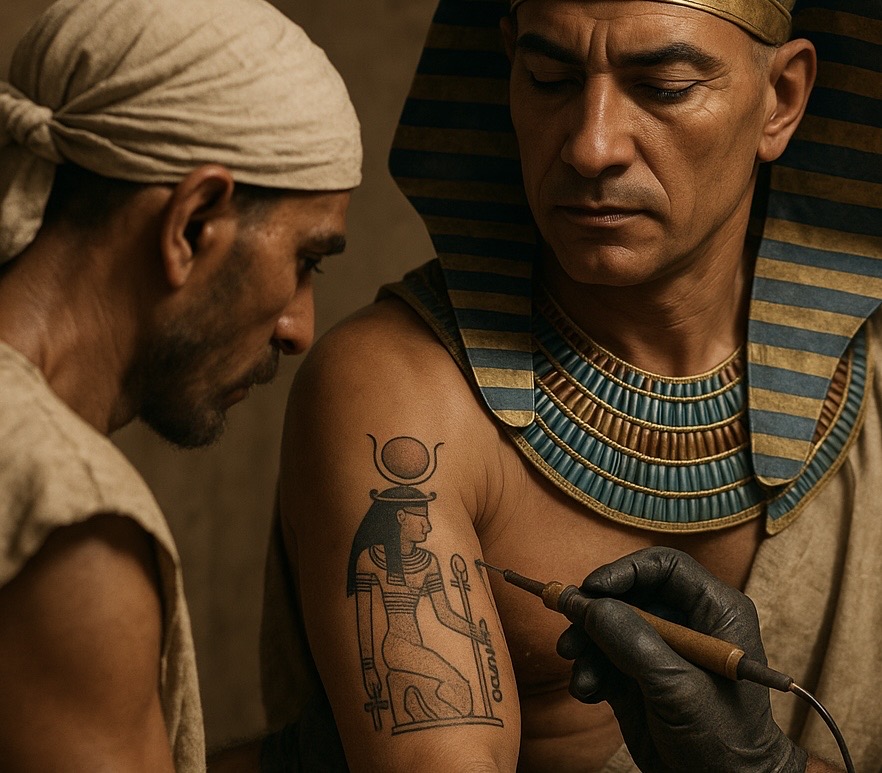How Egyptian History Continues to Shape the Modern Tattoo Industry

Roots in Ritual and Identity:
Our connection runs deeper than aesthetics. Archaeological evidence, like the mummified remains of the Gebelein Woman (c. 3351-3017 BCE) adorned with abstract tattoos possibly linked to fertility or status, proves tattooing existed in Egypt's pre-dynastic era. While the full extent and social context of ancient Egyptian tattooing remain partially veiled, these early marks signify a primal link between ink, the body, and cultural/spiritual expression – a concept central to modern tattooing.
Iconography: A Living Visual Lexicon:
Egyptian art provides an unparalleled repository of instantly recognizable and deeply symbolic imagery that translates powerfully to tattoo art:
1. The Pantheon:
Gods and goddesses like **Isis** (motherhood, magic), **Anubis** (the afterlife, protection), **Bastet** (protection, joy), **Horus** (kingship, the sky), **Ra** (the sun, creation), and **Osiris** (resurrection, the underworld) are perennial favorites. Clients often choose deities representing personal values, life transitions, or desired protection.
2. Sacred Symbols:
The **Ankh** (key of life, immortality), the **Eye of Horus/Ra** (protection, healing, royal power), the **Scarab** (transformation, rebirth, the sun), the **Djed Pillar** (stability, backbone of Osiris), and the **Shen Ring** (eternity, protection) offer potent, concise visual statements rich with meaning.
3. Hieroglyphs & Cartouches:
Individual hieroglyphs representing concepts (like "life," "strength," "beauty") or personalized cartouches encircling names provide unique, deeply personal inscriptions. This taps into the ancient desire to permanently mark identity and invoke power through writing.
4. Pharaonic Imagery:
Profiles of pharaohs (especially Tutankhamun or Cleopatra), Nefertiti's bust, regalia like the Nemes headdress or crook and flail, and majestic sphinxes evoke power, mystery, and historical grandeur.
5. Stylistic Elements:
The distinct Egyptian artistic canon – clear outlines, stylized human and animal forms in profile, hierarchical scale, flat planes of color, intricate patterns – directly influences tattoo styles. This ranges from bold American Traditional interpretations to intricate Neo-Traditional pieces, geometric adaptations, and hyper-realistic portraits.
Impact on the Industry:
1. Client Demand:
Requests for Egyptian themes are consistently high. Artists need familiarity with the mythology and symbolism to consult effectively and create meaningful pieces.
2. Artist Specialization:
Many artists develop expertise in Egyptian iconography, requiring dedicated research into historical accuracy, artistic styles, and cultural context to execute authentic and respectful work.
3. Design Innovation:
The core motifs inspire endless reinterpretation. Artists blend Egyptian elements with other styles (geometric, watercolor, biomechanical, Japanese), create modern deities, or incorporate them into larger mythological or cosmic pieces.
4. Educational Aspect:
Reputable tattoo artists often educate clients about the meanings behind chosen symbols, fostering a deeper appreciation beyond mere aesthetics and promoting cultural understanding.
5. Ethical Considerations:
The industry increasingly acknowledges the importance of respectful representation. While appreciation and inspiration are key, avoiding cultural appropriation by understanding the sacred origins and contexts of symbols is crucial.